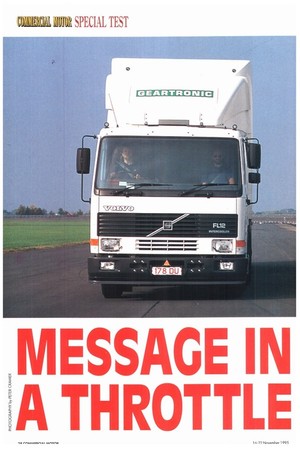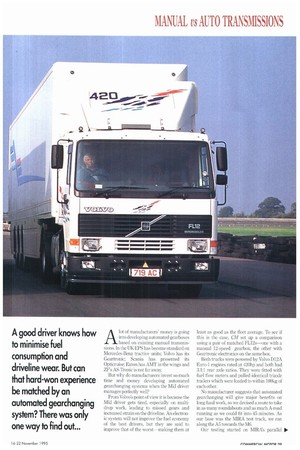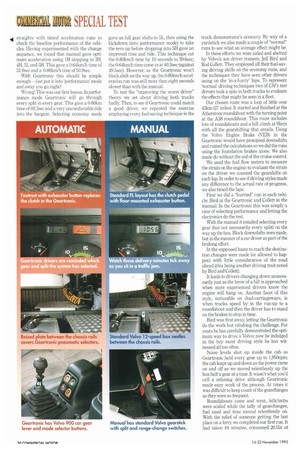SPECIAL TEST
Page 30

Page 31

Page 32

Page 33

If you've noticed an error in this article please click here to report it so we can fix it.
A good driver knows how to minimise fuel consumption and driveline wear. But can that hard-won experience be matched by an automated gearchanging system? There was only one way to find out...
Alot of manufacturers' money is going into developing automated gearboxes based on existing manual transmissions. In the UK EPS has become standard on Mercedes,Benz tractive units; Volvo has its Geartronic: Scania has presented its Opticruise; Eaton has AMT in the wings and ZFS AS-Tronic is not far away.
But why do manufacturers invest so much time and money developing automated gearchanging systems when the MkI driver manages perfectly well?
From Volvo's point of view it is because the Mk' driver gets tired, especially on multidrop work, leading to missed gears and increased strain on the driveline. An electronic system will not improve the fuel economy of the best drivers, but they are said to improve that of the worst—making them at
least as good as the fleet average. To see if this is the case. CM set up a comparison using a pair of matched FL12s—one with a manual 12-speed gearbox, the other with Geartronic electronics on the same box.
Both trucks were powered by Volvo D12 A Euro-1 engines rated at 420hp and both had 3.1:1 rear axle ratios. They were fitted with fuel flow meters and pulled identical triaxle trailers which were loaded to within 100kg of each other.
No manufacturer suggests that automated gearchanging will give major benefits on long-haul work, so we devised a route to take in as many roundabouts and as much A-road running as we could fit into 45 minutes. As our base was the MIRA test track, we ran along the AS towards the M6.
Our testing started on MIRA's parallel straights with timed acceleration runs to check the baseline performance of the vehicles. Having experimented with the change sequence, we found that manual gave optimum acceleration using 1H skipping to 3H, 4H, 5L and 5H. This gave a 0-64km/h time of 31.9sec and a 0-80km/h time of 50.9sec.
With Geartronic this should be simple enough—just put it into 'performance' mode and away you go, right?
Wrong! This was our first lesson. In performance mode Geartronic will go through every split in every gear. This gave a 0-80km time of 69.3sec and a very uncomfortable ride into the bargain. Selecting economy mode gave us full gear shifts to 5L, then using the kickdown (into performance mode) to take the revs up before dropping into 5H gave an improved time and ride. This technique cut the 0-80km/h time by 10 seconds to 59.6sec; the 0-64km/h time came in at 40.3sec (against 49.5sec). However, as the Geartronic won't block shift on the way up, the 0-80km/h acceleration run was still more than eight seconds slower than with the manual.
To test the "improving the worst driver" theory we set about driving both trucks badly. Then, to see if Geartronic could match a good driver, we repeated the exercise employing every fuel-saving technique in the
truck demonstrator's armoury. By way of a yardstick we also made a couple of "normal" runs to see what an average effect might be.
In these efforts we were aided and abetted by Volvo's ace driver trainers, Jeff Bird and Rod Collett. They employed all their fuel-saving driving skills on the economy runs, and the techniques they have seen other drivers using on the 'in-a-hurry' laps. To represent 'normal' driving techniques two of CM'S test drivers took a spin in both trucks to evaluate the effects that might be seen in a fleet.
Our chosen route was a loop of little over 43km (27 miles). It started and finished at the Atherstone roundabout with the turning point at the A38 roundabout. This route includes lots of roundabouts and a hill climb at Hints with all the gearshifting that entails. Using the Volvo Engine Brake (VEB) in the Geartronic would have prompted downshifts and ruined the calculations so we did the runs using the foundation brakes alone. We also made do without the aid of the cruise control.
We used the fuel flow meters to measure the strain on the engine: to evaluate the strain on the driver we counted the gearshifts on each lap. In order to see if driving styles made any difference to the actual rate of progress, we also timed the laps.
First we did a "hurried" run in each vehicle; Bird in the Geartronic and Collett in the manual. In the Geartronic this was simply a case of selecting performance and letting the electronics do the rest.
With the manual it entailed selecting every gear (but not necessarily every split) on the way up the box. Block downshifts were made, but in the manner of a car driver as part of the braking effort.
In the supposed haste to reach the destination changes were made (or allowed to happen) with little consideration of the road ahead (this being another driving trait noted by Bird and Collett).
It leads to drivers changing down unnecessarily just as the brow of a hill is approached when more experienced drivers know the engine will hang on. Another facet of this style, noticeable on dual-carriageways, is when trucks speed by in the run-up to a roundabout and then the driver has to stand on the brakes to stop in time.
Bird was first away, letting the Geartronic do the work but relishing the challenge. For years he has carefully demonstrated the optimum way to drive a Volvo; now he indulged in the boy racer driving style he has witnessed all too often.
Noise levels shot up inside the cab as Geartronic held every gear up to 1,950rpm; the cab leapt up and down as the power came on and off as we moved relentlessly up the box half a gear at a time. It wasn't what you'd call a relaxing drive although Geartronic made easy work of the process. At times it was difficult to keep count of the gearchanges as they were so frequent.
Roundabouts came and went, hillclimbs were scaled while the tally of gearchanges, fuel used and time moved relentlessly on. With the relief of someone getting the last place on a ferry we completed our first run. It had taken 44 minutes, consumed 20.51it of fuel and Bird had provoked the Geartronic into 142 gear changes.
Bringing up the rear, and making equally valiant efforts, was Collett in the manual FL12. He was pushing equally hard: taking the revs well above the 1,100-1,700rpm green band before climbing half a gear he inched his way up the box.
In that way he put the transmission through most, though not all ratios. His run lasted 46 minutes used 19.5Iit of fuel and clocked up an arm-aching, clutch-burning 93 gearchanges.
On the economy runs life was far more laid back. Most of the boy-racer driving techniques were reversed. For example, the drivers considered the road ahead when driving the manual—Bird changed from 4L to 6H after cresting a hill, Foundation brakes (but not the VEB) were used instead of the gears to slow the vehicle.
In the Geartronic model Bird switched the system to economy and made use of the "hold" button where appropriate. Full accelerator travel was used but not to the extent of activating the kickdown switch.
This not only allowed us to complete the course in a civilised manner but also to do it a full minute quicker, using three litres less fuel with just 74 gearchanges.
Collett was also having a more relaxed time in the manual FL12. He was quicker by four minutes, used almost two litres less fuel and more than halved the gearchanges. When it came to CM'S "normal" drivers, the results were not as clear as the benefits to the drivers themselves.
When driving the manual FL, the change pattern which gave the quickest acceleration times on the test track was used. Geartronic was used in economy mode.
On the hill at Hints the electronics switched automatically into performance mode until we reached the summit.
By driving the manual with reasonable regard for economy, one driver managed to get exactly the same fuel result on both vehicles. However, the journey time was 11% quicker in the Geartronic and his stress level was reduced considerably.
Our other "normal" driver had almost the reverse results. Having hit a couple of extra lights on red, the manual's journey time was slightly slower but the Geartronic used 7% less fuel.
This is in line with Volvo's general experience. "For the majority of drivers, we get a 6-10% improvement in fuel economy on city distribution work," says Bird. Its not that the driver is bad, but that the electronics can monitor the engine continuously and keep it at its most economic all the time." This is one reason the Geartronic consistently makes more gearchanges than the normal driver. "Also, Geartronic does not get tired at the end of the day," says Bird.
SUMMARY
If drivers want to abuse a vehicle they can do it even better with a Geartronic and the very best drivers can turn in better fuel economy with a manual box. But for the majority the Geartronic's consistency will probably show a fuel economy improvement. With the advent of Euro-2, torque is dropping off dramatically at the top end so the potential fuel penalty is set to increase if drivers consistently take the needle out of the green band.
On multi-drop operations our test has shown that there are fuel benefits to be gained from the Geartronic's vigilance when it comes to engine revs. Other semi-automated systems can offer similar improvements. The potential improvements in fuel economy that we have demonstrated could more than offset the Geartronic's £2,000 price premium. And from the driver's point of view the stress reduction must be welcome.
CI by Colin Sowman
AUTOMATIC
Footrest with exhauster button replaces the clutch in the Geartronic.
rtronic drivers are reminded which sear and split the system has selected.
Raised plate between the chassis rails covers Geartronic pneumatic selectors.
Geartronic has Volvo 900 car gear lever and mode selector buttons.
MANUAL
Standard FL layout has the clutch pedal with floor-mounted exhauster button.
Watch those delivery minutes lick away as you sit in a traffic jam.
Standard Volvo 12-speed box nestles between the chassis rails.
Manual has standard Volvo gearstick with split and range-change switches. SPECIFICATION
RETMI Volvo FU 2 420 4x2 tractive unit with sleeper cab. Plated GCW: 38 tonnes.
Design GVW: 52 tonnes.
Manufacturer: Volvo Truck and Bus, Wedgnock Lane, Warwick CV34 5YA ENGINE Dl 2A420 Euro-1 charge-cooled, direct-injection Four-shake diesel, Cylinders: Six in-line, Bore/sirake: 131x150mm.
Capacity: 12.1 litres.
Compression ratio: 17.5:1
Maximum net power: 41,4hp I309kW) at 1,800rpm.
Maximum net torque: 1,364Ib1t (1,850Nm) between I , I 00 and 1,300rpm.
TRANSMISSION MANUAL Make: Volvo SRI 900 range change and splitter synchromesh gearbox with 12 speeds and two crawler gears.
Ragas: 11.13, 8.92, 7,16, 5 74, 4.68, 3.75,2.97, 2 38, 1 91, 1.53, 1.25, 1.0:1.
Final drive: 3.1:1.
Clutch: Non-asbestos single dry plate with hydraulic assisted
operation. Diameter: 432mir TRANSMISSION: GEARTRONIC Make: Volvo.
Model: Fully automated SRI 900 with 12 speeds and two crawler gears.
Ratios: 11.13, 8.92,7,16, 5.74,4.68, 3.75,2.97, 2.38, 1.91, 1.53, 1.25, 1.0:1, Final drive: 3.1:1.
Clutch: Non-asbestos single dry plate with assisted hydraulic operation Diameter 432mm.
BRAKING SYSTEMS: Full air with dual circuit (front/rear split).
Air reservoirs: 90 litres capacity.
Parking: Spring operated on both axles.
Exhaust. Volvo VEB.
Brake dimensions: Front, 410mm diameter by 175mm width;
rear, 410mm diameter by 225mm width.
TEEPIt Recirculating ball with power assistance. IBM Pressed channel section steel cold riveted, 275mm deep by 90mm wide by 7mm thick. Suspension: Front, parabolic spring with anti-roll bar; rear, electronically controlled four-bag air. Wheelbase: 3.8m.
Axle design weights: Front, 6.7 tonnes; rear, 13 tonnes. Wheels and lyres: 295/80822.5. Fuel tank: 410 litres, aluminium.
REMOMMI 24V negative earth. Battery: 2x170Ah.
Generator: 55A alternator.
TEST TRAILER Two identical I 3.5m Made dry freight bodied trailers, height, Am; tare weight, 7.2 tonnes.
TERMS OF WARRANT' Twelve months unlimited distance with two-year (200.000km) driveline warranty with operator servicing or three years/300,000km ii serviced by franchised dealer.
DEALERS AND SERVICE POINT Volvo has 24 distributors and 62 dealer point's in 11-e JK and Ireland.
ACCELERATION Manual km/h secs gear 0-80 50.9 IH, 2H, 3H, 4H, 5L, 5H.
0-64 64 Geartronic km/h secs gear 0-80 59.6 11, 21, 31,41, 51, 5H.
0-64 40.3




























































































































